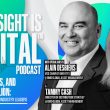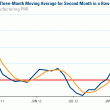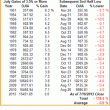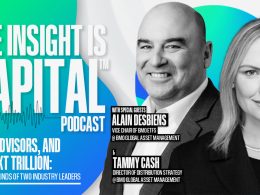Axel Merk, Merk Investments
Aug 6th, 2013
In the short to medium term, the U.S. dollar and currencies are heavily influenced by what the Fed may be up to next. As the Federal Reserve (Fed) may be reading tealeaves as much as anyone else, we may be facing particularly high policy uncertainty that, in turn, reflects on elevated volatility in the bond and currency markets. The good news is that this may yield opportunities for the prudent investor.
The Fed
Taper vs. Tighten? Yellen vs. Summers? A little more than halfway through the year and there is much debate about the course of Fed policy with respect to winding down asset purchases (QE) and the timing of the first rate hike off of the zero lower bound. Part of the confusion stems from the fact that the Fed can’t read its traditional gauges, namely the market’s perception of how bonds should be priced. As the Fed manages much of the yield curve (short-term through long term rates), policy makers appear to be ever more focused on any new data point on the economy. Adding to the uncertainty is that Bernanke’s term is coming to an end on January 31, 2014 and President Obama looks set to nominate a successor this fall.
For starters, the word “tapering” for all of its repetition in the press may not be the right way to think about how the QE program will evolve from here. The idea of tapering implies a gradual reduction, i.e., if the Fed announces a reduction in monthly purchases it will be followed by further reductions until the program is entirely discontinued. Let’s not forget that the Fed exited QE 1 and QE 2 only to be followed with further QE. Rather than go on with QE 3, 4… etc., the Fed announced an opened ended QE program in September 2012, which was the start of what is called QE 3. Once the Operation Twist program ended in December 2012, the Fed initiated $45 billion per month in outright Treasury purchases in addition to the $40 billion per month in MBS purchases, “QE 3.1” if you will. After the tapering talk started, the Fed made clear that it may decrease or increase its monthly asset purchases going forward depending on the outlook for the labor market and inflation, or that it may decrease and then subsequently increase monthly purchases, perhaps heralding in the “QE 3.2” phase.
Also, tapering QE does not mean tightening policy in terms of short-term rates, and the Fed has recently made a concerted effort to make that distinction. The two, QE tapering and Fed funds rate policy, are seen by some as tied because tapering suggests a move towards normalization of policy that would eventually take the Fed funds rate off of the so-called zero lower bound. While there seems to be debate among Fed officials as to the efficacy of QE and the cost/benefit trade off, there seems to be consensus, certainly among the dovish camp which we believe is in control of today’s Fed, that rates should remain extraordinarily low well after QE ends and for a very long time in general.
Meanwhile, Bernanke has all but entered full-on lame duck status, in which case the future of QE will be set by his successor and the current talk may be moot. As with any public policy maker, Bernanke may be concerned about his legacy as he winds down his tenure as Fed Chair. As he looks to seal his legacy Bernanke may aim to highlight some improvement in the labor market, scale down monthly purchases, claim some partial victory with his QE policies, and leave the problem to his successor. Saying things are getting better and making the first move to withdraw his unprecedented easing policies may make sense, i.e., declare victory and withdraw (at least temporarily). In our view a steady tapering of the QE program is far from a foregone conclusion.
In any case, the most important question is who will succeed Bernanke. Janet Yellen, Larry Summers, and Donald Kohn appear to be the names on Obama’s short list. Summers has emerged as the President’s favorite, no doubt a seasoned Washington wheeler-dealer who just may be able to get what he wants. Nevertheless, Summers is a polarizing figure who has made a lot of enemies in Washington, and many in Congress and the news media have come out either for Yellen or specifically against Summers. While Summers does indeed appear to be Obama’s preferred choice, our view is that Yellen will more likely carry the day. We see Yellen as the likely candidate for a number of reasons: experience (Chair of Council of Economic Advisers, President of the San Francisco Fed, Fed Vice Chair), political affiliation (Democrat), gender (female), monetary policy ideology (dovish and people know where she stands). Most relevant to the market is her ideology, where she is regularly scored as more dovish than Bernanke. Any change in leadership would provide an opportunity for modifications to the policy and messaging of the Fed, which could have dramatic ramifications for the currency markets. As far as Summers is concerned, while without a doubt he would like to be able to check off “Fed Chair” on his bucket list, we think he is better positioned to influence Washington politics from outside rather than inside the Fed.
We believe this lingering uncertainty fosters volatility in all markets: with the longer term course of the Fed unclear, the markets have yet another excuse to over-interpret the news of the day rather than price risk in terms of a longer term trajectory of monetary policy.
As far as economic data are concerned, we believe the glass may be half full, even if the markets perceive some data points as the glass half empty. More to the point:
• As mortgage rates have risen substantially, odds are high that the housing recovery might stall. There’s little evidence of a building boom: instead, even as there has been upward momentum in prices, we believe the recovery was mostly driven by low interest rates. Bernanke has specifically pointed to this risk; we believe Bernanke, just as Yellen if she succeeds him, may further taper the taper talk should housing disappoint.
• Unemployment reports continue to paint a mixed picture. Ahead of the implementation of Obamacare, employers have an incentive to shift full-time jobs to part-time jobs, as no healthcare will need to be provided for part-time employees. Most recently, the average number of hours worked per week fell; even the hourly wage fell. And then there’s the persistently declining labor participation rate. In the past, Bernanke had shrugged off the low and declining labor participation rate as a sign of an ageing society; someone must have shown him a more detailed analysis, however, as the elderly are working more; but those in their prime working years appear participating less and less.
• Corporate earnings have done okay, but a number of sectors have had disappointing sales. It’s easy to blame what was generally a stronger dollar in the first half of the year for sub-par performance, but ultimately blaming currency swings may be be an excuse more than a cause for missing investor expectations. Weak sales suggest this economic recovery is not as strong as rising stock prices suggest.
In this context, there may be a lot of work for the markets to taper its taper expectations. As the dollar has risen on the backdrop of taper talk, we expect the greenback to face headwinds. On that note, should there be a strong economic recovery, the dollar might also weaken, as – historically – the dollar has often weakened in early to mid phases of an economic recovery; that’s because foreigners are less inclined to buy U.S. bonds when there’s a bond bear market.
Gold:
Gold has been seriously out of favor over the first half of the year. Having had twelve consecutive up years it is not surprising that the precious metal experienced a major correction, although it experienced a remarkable capitulation in the second quarter. To put it into context, there were a lot of non-fundamentally driven buyers that came into the market during the run up to the highs of 2011, chasing the trend, using leverage, and only interested in the idea of speculating on further price increases in the shorter term. Those marginal buyers have since then gone to the exits and indeed some have come in aggressively on the short side, exacerbating the trend in the opposite direction. Importantly from our standpoint, the fundamentals are still very positive as many parts of the world, including the US, are burdened with too much debt and the path of least resistance remains inflation and a gradual debasement of the purchasing power of the currency. In our assessment, the US and many other governments around the world cannot support their bonds should their cost of borrowing rise significantly. In that sense, the sluggish recovery has been a godsend to governments. Taper talk might be hazardous to the price of gold, but we don’t see any central banker of the caliber of former Federal Reserve Chair Paul Volcker, who was willing to substantially raise rates to fight inflation. Pundits say inflation is not the problem of the day; they may be right, but the day will come where it just might be a problem. We don’t doubt the intentions of policy makers of fighting inflation, but we doubt their ability. In past discussions we have had with Don Kohn, a recent addition to the shortlist of potential Fed Chairs, he makes it appear that conducting monetary policy is akin to a walk in the park. When we have expressed to him that there’s too much leverage in the economy for the Fed to tighten in earnest, he shrugged off the concern, arguing the Fed could always fine-tune rates. He certainly does not lack confidence that he could navigate the Fed. But we doubt it’s going to be a walk in the park, no matter who gets the job. And we believe, ultimately, the Fed will have to err on the side of inflation, boosting the long-term prospects of the shiny metal.
Euro
The much unloved euro has managed to appreciate against the dollar last year as well as so far this year. One underreported driver: while the Fed continues to print money, the ECB’s balance sheet is actually shrinking. The ECB doesn’t have the same monetary tools and flexibility that the Fed has and in our view that will be to the benefit of the value of the euro vs. the dollar. The ECB has a demand driven balance sheet, where liquidity has been drained from the system as banks have returned loans. Add to that improving current account balances in peripheral Eurozone countries, as well as an overall current account for the Eurozone that’s roughly in balance, and the euro may be “cursed” to go higher, even as economic growth remains sluggish (albeit improving) and ECB President Draghi has tried to talk down the euro. Furthermore, for now the talk of negative deposit rates by the ECB has tailed off. The ECB’s dovish tone of late may subside in line with the relatively hawkish tone of the Fed getting walked back with mixed economic data and higher interest rates on the long end.
British pound
It has been a month since Mark Carney took the helm of the Bank of England. As soon as his first policy meeting, Carney signaled the central bank will introduce forward guidance on the rate path. He will have more chance to clarify the forward guidance this Wednesday along with the widely watched inflation report. While Carney previously favored nominal GDP targeting, another possible course is that the BoE will follow the Fed in linking policy action with the jobs market, by making rate hikes conditional on a significant drop in the unemployment rate. One thing Carney has already brought to the pound is higher volatility: since July the pound has been more volatile than the euro.
We maintain our bearish call on the British pound over the next twelve months. While some interpreted the BoE’s recent unanimous decision against more QE as a hawkish signal, we view this as simply a tactical move to the formal announcement of the forward guidance. Moreover, among the nine members on the BoE’s monetary policy committee, four members’ current terms will expire in 2014, including two deputy governors who are not seeking reappointment. Carney will have a good chance to reshuffle the board and push forward his preferred policy strategy. Stay tuned.
Japanese yen
Late last year we published a piece “Is the Yen Doomed?” and in our January currency outlook, we removed the question mark. As of this writing, the yen has weakened more than 11% against the dollar year-to-date. Investors have stopped looking at the yen as a safe haven. Indeed, the yen’s implied volatility has been the highest among all G10 currencies.
Our price target for the yen is infinity, meaning that we believe the yen will be worthless down the road. The policymakers of Japan are unaware of the dynamics they are unleashing. Prime Minister Abe’s three arrows – money printing, fiscal stimulus and structural reform – have all boosted inflation expectations and weakened the value of the yen. Good for the Japanese exporters but dangerous for the massive government debt. With a 200-percent-plus debt-to-GDP ratio, it’s not unlikely the government will lose control. Once inflation picks up as policymakers want, the cost of borrowing on the government debt may soon become too high to sustain as higher inflation gets priced into yields, and the Bank of Japan will have to intervene to prevent that from happening.
Another changing dynamic is that Japan’s current account is sliding toward a deficit. It matters for the yen because Japan will have to rely on foreigners to finance its budget deficits in the future. Abe’s ruling coalition has gained control of both houses after a decisive victory in the July upper house election, but this hasn’t secured a clear fiscal roadmap for Japan. The challenge is obvious: to materially improve Japan’s fiscal situation, the national sales tax needs to double to 10%, but the tax increase could subtract 0.6 percentage points from GDP growth in fiscal year 2014/15, threatening the yet vulnerable economic recovery.
Aussie
As the highest yielding currency1 in the G10 the Aussie is a favorite for the carry trade strategy, a strategy that goes long a high yielding currency (e.g., the AUD) vs. a low yielding currency (e.g., the USD). It is also a commodity currency as Australia exports industrial raw materials such as iron ore and coal, among others, to emerging markets, China in particular. The Aussie was the worst performer in the G10 in H1 2013 in large part due to two key drivers: changing expectations about short-term interest rates and concerns about growth in China. Given the actions and communication of the Reserve Bank of Australia (RBA), short-term interest rates in Australia have declined, and importantly, expectations for even lower rates prevail in the market. This makes the carry trade less attractive and has driven some unwinding out of the long AUD vs. USD trade, which has put downward pressure on the Aussie. Additionally, as there are two sides to every currency pair, expectations of rate hike sooner rather than later in the U.S. have exacerbated the unwinding of this carry trade. Separately, fears about slower growth in China have impacted expectations about commodity demand from Australia, which has further weakened the currency. Additionally, the recent shake-up in the Australian government and the upcoming September election introduces more uncertainty to the prospect of the Aussie. We expect headwinds for the Australian dollar to continue, with the caveat that its substantial selloff might allow it to bounce back temporarily. But it may take a while for the Aussie to find a firm footing given, amongst others, also a deteriorating domestic budget outlook and investment cutbacks in the commodity sector that won’t be reversed on short-notice. In fact, we think the Aussie would have dropped far more had it not been for the ultra-loose policies originating in Japan.
Kiwi
Similar to the Aussie, the Kiwi is a high yielding commodity currency2. There are some important distinctions that need to be made however. Based on their latest policy statement the Reserve Bank of New Zealand (RBNZ) looks set to start a tightening cycle in contrast to expectations that the RBA will further cut their benchmark rate. Also, New Zealand is a large commodity producer and exporter, but is more heavily geared towards soft commodities such as dairy rather than the heavy industrial commodities of Australia. In other words, New Zealand may have far less exposure to a slowdown in China than that of Australia. For all intents and purposes the Kiwi is now the highest yielding currency in the G10 and may well benefit from carry trade popularity more than the Aussie when the carry trade comes back into fashion. Going against the New Zealand dollar is that this may all be priced in already, indeed, it has rightfully outperformed the Australian dollar of late. Still, we believe New Zealand’s monetary policy will surprise the world by being more hawkish than many expect.
Chinese Renminbi
Within a few months of taking office, China’s new leadership has demonstrated its commitment to real reform. In the currency market, it’s reflected in the fact that the administration didn’t engage in competitive devaluation this year. Instead, the Renminbi has exhibited impressive strength and stability, in particular compared to the Japanese yen. Year-to-date, the Renminbi has strengthened by over 1.6% against the dollar, more than 1.03% in the full year of 2012. Meanwhile, it appreciated more than 15% against the Japanese yen.
More broadly speaking, the new leadership has made structural reforms and deleveraging their top policy priority. By targeting a lower GDP growth rate, the Chinese government is now seeking sustainable quality growth. It also lifted the interest rate cap on financial institutions, a key step toward China’s interest rate marketization reform and the development of a more vibrant fixed income market. The central government will also launch a second round of nationwide auditing on local government debt, with the aim to safeguard the national economy. All of these initiatives and reforms are positive for the Renminbi in the long term.
Emerging markets currencies: We stay positive on the Korean won, the Malaysian ringgit and the New Taiwan dollar. Despite recent market volatility, all these currencies have been relatively resilient, benefiting from respective countries’ strong external positions, reflected by large foreign reserves and current account surpluses. We also like these currencies’ low correlation (and lower correlation compared to other EM currencies) with the U.S. markets.
Benign inflation has also given central banks of Korea, Malaysia and Taiwan the space to stay on hold while waiting for the recovery to gain speed. Let’s also keep in mind that Japan’s policies to debase its currency are not all threatening to the region: the expansionary policies may lead to significant investments throughout the region, providing a significant stimulus to regional economies.
In contrast, central banks of Indonesia and Brazil recently raised interest rates to fight rising inflation, though they haven’t successfully bolstered investor confidence to stay in the local currency. For more analysis, click here to read our recent whitepaper on emerging market currencies.
We have an in-depth discussion about gold in our upcoming Webinar on August 22nd: please click here to register. Importantly, please make sure you are subscribed to our newsletter so you know when the next Merk Insight becomes available.
Axel Merk is President and Chief Investment Officer, Merk Investments, Manager of the Merk Funds.
Reader commentaries. To add a commentary, please click here.
1The Reserve Bank of Australia (RBA) has an official overnight rate of 2.75% as of 1 August 13
2The Reserve Bank of New Zealand (RBNZ) has an official overnight rate of 2.50% as of 1 August 13
This report was prepared by Merk Investments LLC,and reflects the current opinion of the authors. It is based upon sources and data believed to be accurate and reliable. Merk Investments LLC makes no representation regarding the advisability of investing in the products herein. Opinions and forward-looking statements expressed are subject to change without notice. This information does not constitute investment advice and is not intended as an endorsement of any specific investment. The information contained herein is general in nature and is provided solely for educational and informational purposes. The information provided does not constitute legal, financial or tax advice. You should obtain advice specific to your circumstances from your own legal, financial and tax advisors. As with any investment, past performance is no guarantee of future performance.
















